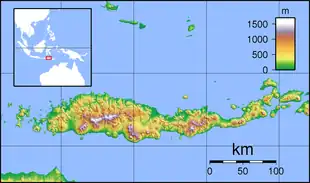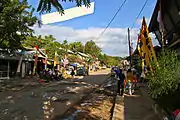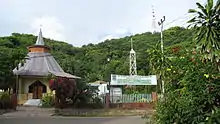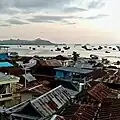Labuan Bajo | |
|---|---|
 View of the port of Labuan Bajo | |
 Labuan Bajo Location in Indonesia  Labuan Bajo Labuan Bajo (Indonesia) | |
| Coordinates: 8°30′S 119°53′E / 8.500°S 119.883°E | |
| Country | Indonesia |
| Region | Lesser Sunda Islands |
| Province | East Nusa Tenggara |
| Regency | West Manggarai |
| Population (2010 Census) | |
| • Total | 5,774 |
| Time zone | UTC+8 (WITA) |
Labuan Bajo is a fishing town located at the western end of the large island of Flores in the East Nusa Tenggara province of Indonesia. It is the capital of the West Manggarai Regency, one of the eight regencies which are the major administrative divisions of Flores.
Tourism
Once a small fishing village, Labuan Bajo (also spelled Labuhanbajo and Labuanbajo) is now a tourist center as well as a centre of government for the surrounding region.[1] Roads link Labuan Bajo to other towns across Flores such as Ruteng, Bajawa, Ende and Maumere. Facilities to support tourist activities are expanding quickly although the rapid rise in the numbers of visitors is imposing some strain on the local environment.[2]
Komodo National Park
Labuan Bajo is the gateway for trips across the nearby Komodo National Park to Komodo Island and Rinca Island, both home to the famous Komodo dragons. The islands in Labuan Bajo have a beautiful natural charm, one of which is a water destination with underwater views and a variety of charming marine life. There are numerous snorkeling points in the islands close to Labuan Bajo. Kanawa and Seraya Islands, for example, offer good diving and snorkeling sites. Currents can be strong at some sites however so care is needed.[3] Every evening at Kalong Island, to the south of Labuan Bajo, thousands of flying fox bats (known as burung kalong in Indonesian) provide an amazing display. Around dusk, the bats rise from the mangroves around Kalong Island and within a few minutes, a column begins to form as thousands of bats begin to traverse across to the main island of Flores to the east. More and more bats join the column for perhaps the next 30 mins or so. The column soon forms a remarkable trail across the sky stretching for miles as the bats fly east to Flores to search for food in the nearby forests.
Environmental tourism
Other features nearby Labuan Bajo include several waterfalls, trekking, and many diverse beaches. The town is small and can easily be traversed on foot in 15 minutes.Mirror stone cave (Batu cermin cave) is only 4 km away.[4] Wae Rebo Village, 7 hours away by car, can be visited to learn about the indigenous culture of the area.[5] The village is known for their traditional houses called Mbaru Niang.

Tourism development
In Labuan Bajo, tourism development has had a great impact on the economy by creating job opportunities for the local population and increasing revenue in the area.[6] Total accommodations has also increased in the area. In 2019, the area included 13 five-star hotels, 68 non-star hotels, 4 villas, and 26 dormitories.[6]
Transport

Komodo Airport is located just 2 km from the center of Labuan Bajo and has 4–6 daily flights arriving from Denpasar in Bali and elsewhere. Labuan Bajo port has daily ferry departures to the town of Bima to the west on the large island of Sumbawa and weekly or bi-weekly departures to Denpasar and Sulawesi. There are also direct flights from Jakarta to Labuan Bajo by Garuda Indonesia and Batik Air.
Economy
The local economy in the town is centred around the ferry port and tourism, local shops and restaurants, and the diving trade. Most of the foreign tourists are European, many from Italy, and also from Australia and the United Kingdom. The wider area produces fish and palm oil; there is also a large amount of subsistence agriculture in the villages in the region where living standards are still low. Levels of poverty in the rural areas are high.
The national and regional governments made 2012 a year to promote regional tourism around Labuan Bajo and the nearby Komodo National Park with a six-month festival from July until December 2012.[7]
Climate
Labuan Bajo has a dry "winter" tropical savanna climate (Aw), with moderate to little rainfall from April to November and heavy rainfall from December to March.
| Climate data for Labuan Bajo | |||||||||||||
|---|---|---|---|---|---|---|---|---|---|---|---|---|---|
| Month | Jan | Feb | Mar | Apr | May | Jun | Jul | Aug | Sep | Oct | Nov | Dec | Year |
| Mean daily maximum °C (°F) | 30.4 (86.7) |
29.8 (85.6) |
30.5 (86.9) |
31.0 (87.8) |
30.8 (87.4) |
30.4 (86.7) |
30.4 (86.7) |
30.9 (87.6) |
31.5 (88.7) |
31.9 (89.4) |
31.5 (88.7) |
30.7 (87.3) |
30.8 (87.5) |
| Daily mean °C (°F) | 25.6 (78.1) |
25.3 (77.5) |
25.7 (78.3) |
25.8 (78.4) |
25.3 (77.5) |
24.7 (76.5) |
24.1 (75.4) |
24.4 (75.9) |
25.2 (77.4) |
26.0 (78.8) |
26.5 (79.7) |
26.0 (78.8) |
25.4 (77.7) |
| Mean daily minimum °C (°F) | 20.9 (69.6) |
20.9 (69.6) |
20.9 (69.6) |
20.6 (69.1) |
19.9 (67.8) |
19.0 (66.2) |
17.9 (64.2) |
17.9 (64.2) |
18.9 (66.0) |
20.2 (68.4) |
21.5 (70.7) |
21.3 (70.3) |
20.0 (68.0) |
| Average rainfall mm (inches) | 291 (11.5) |
274 (10.8) |
196 (7.7) |
103 (4.1) |
80 (3.1) |
42 (1.7) |
25 (1.0) |
24 (0.9) |
21 (0.8) |
46 (1.8) |
118 (4.6) |
205 (8.1) |
1,425 (56.1) |
| Source: Climate-Data.org[8] | |||||||||||||
Gallery
 Main street
Main street Saint Angela Church
Saint Angela Church Harbour
Harbour Masjid Agung Nurul Falaq
Masjid Agung Nurul Falaq Labuan Bajo harbour
Labuan Bajo harbour The main port building
The main port building
References
- ↑ Benito Lopulalan, 'Growing Tourism on Flores' Archived 2012-04-29 at the Wayback Machine, The Jakarta Globe, 24 February 2009.
- ↑ Markus Markur, 'Labuan Bajo faces challenges with rising tourism', The Jakarta Post, 7 September 2017.
- ↑ Diving near Komodo and Rinca Islands.
- ↑ "Wonderful Indonesia - Gua batu cermin". Wayback Machine. Archived from the original on 4 March 2016. Retrieved 12 February 2018.
- ↑ "THE ROLE OF COMMUNITY IN THE DEVELOPMENT OF WAE REBO AS A COMMUNITY-BASED TOURISM DESTINATION IN EAST NUSA TENGGARA" (PDF).
- 1 2 "Perubahan Sosial Ekonomi Masyarakat Labuan Bajo Akibat Pembangunan Pariwisata".
- ↑ 'E. Nusa Tenggara to hold Komodo Festival', Antara News, 21 October 2011.
- ↑ "Climate: Labuan Bajo". Climate-Data.org. Retrieved 18 November 2020.
External links
 Labuan Bajo travel guide from Wikivoyage
Labuan Bajo travel guide from Wikivoyage